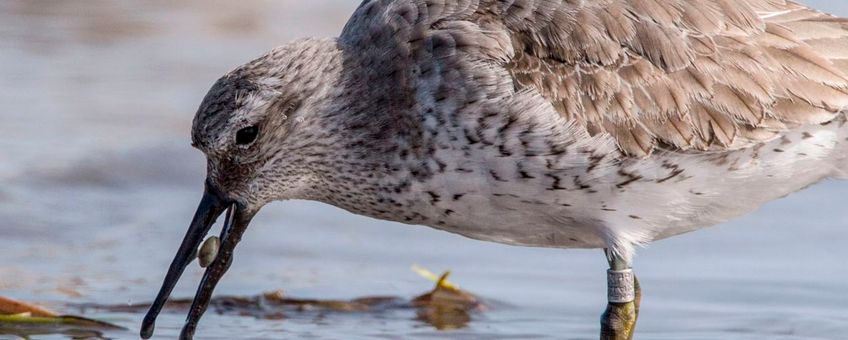
Shrinking shorebird pays the bill for rapid Arctic warming while wintering in the tropics
NIOZ Royal Netherlands Institute for Sea ResearchClimate change makes animals smaller
Shrinkage of animal body size has just recently been discovered, but is already considered a universal response to climate change as it is observed across a broad range of animal taxa. Up to now, two competing hypotheses explain the reduction in animal body size. On the one hand, there is the hypothesis that a smaller body is better able to dissipate body heat because of the larger surface to volume ratio. On the other hand, there is the hypothesis that bodies are shrinking because climate change disrupts the ability of a consumer to find enough of the right food at the right time, leading to malnutrition during the juvenile life stage.
Arctic animals shrinking fastest?
As the High Arctic is warming up most rapidly, body shrinkage is expected to be most extreme in this region. However, many organisms breeding in the High Arctic are long-distance migrants, spending the nonbreeding season at much lower latitudes, often as far as the tropics, where the impacts of climate change are less obvious.
 Jan van Gils from NIOZ Royal Netherlands Institute for Sea Research explains: “The red knot (Calidris canutus canutus) is one of the world’s most northerly breeding birds and a well-known long-distance migrant. It is nesting in northern Taimyr (Russia) and is wintering in tropical coastal ecosystems, notably the Banc d’Arguin, Mauritania (West Africa). Analysis of satellite images has shown that over the past 33 years, snow at the red knot’s breeding grounds has progressively melted earlier, at a rate of half a day per year, so that’s now more than two weeks. The retreat of the snow marks the start of the insect peak in the Arctic (Fig. 1); the main food source of the chicks before they leave the Arctic. Juvenile red knots that we caught along the Baltic coast while on their way to West Africa were smaller and had shorter bills after warm Arctic summers”.
Jan van Gils from NIOZ Royal Netherlands Institute for Sea Research explains: “The red knot (Calidris canutus canutus) is one of the world’s most northerly breeding birds and a well-known long-distance migrant. It is nesting in northern Taimyr (Russia) and is wintering in tropical coastal ecosystems, notably the Banc d’Arguin, Mauritania (West Africa). Analysis of satellite images has shown that over the past 33 years, snow at the red knot’s breeding grounds has progressively melted earlier, at a rate of half a day per year, so that’s now more than two weeks. The retreat of the snow marks the start of the insect peak in the Arctic (Fig. 1); the main food source of the chicks before they leave the Arctic. Juvenile red knots that we caught along the Baltic coast while on their way to West Africa were smaller and had shorter bills after warm Arctic summers”.
Shrinking migrants pay the bill in the tropics
Once they have arrived in West Africa, the smallest young birds pay the price of having a short bill: their survival was only half of that of the larger juveniles. Van Gils: “The reason for this bill-length dependent mortality is quite straightforward. Only larger birds with long bill were able to reach the relatively deeply burrowed bivalves at Banc d’Arguin (Fig. 2). Shorter-billed birds were forced to live on seagrass, which is a poor food source for these birds. The poor survival of shrunken first-year birds clearly contributes to the current population decline seen in red knots nowadays”.
Not only body size, but also body shape changes
 The high premium on having a long bill, causes red knots also to change body shape (Fig. 3). Nowadays red knots are smaller, but since the short-billed small birds are selected against, the ones with the highest survival chances are relatively long-billed.
The high premium on having a long bill, causes red knots also to change body shape (Fig. 3). Nowadays red knots are smaller, but since the short-billed small birds are selected against, the ones with the highest survival chances are relatively long-billed.
Van Gils concludes: “Since smaller birds do worse than larger ones, we reject the hypothesis that body shrinkage is evolutionarily beneficial. Instead, we suggest that a so-called ‘trophic mismatch’ during chick stage underlies the smaller knot body: due to the rapidly advancing Arctic summer, juvenile knots are now simply born after the rapidly advancing insect peak. We therefore propose that changes in body size and shape, and the negative population dynamical consequences, will be widespread among other High-Arctic breeding species in the future. This is a very serious ecological effect which requires our immediate attention”.
These findings will be published Friday 13 May 2016 in Science by an international team of researchers from the Netherlands (NIOZ and University Groningen), Australia (Deakin University), France (CNRS), Poland (University Gdańsk), and Russia (Moscow University).
Text: NIOZ Royal Netherlands Institute for Sea Research
Photos: Jan van de Kam; Jan van Gils
